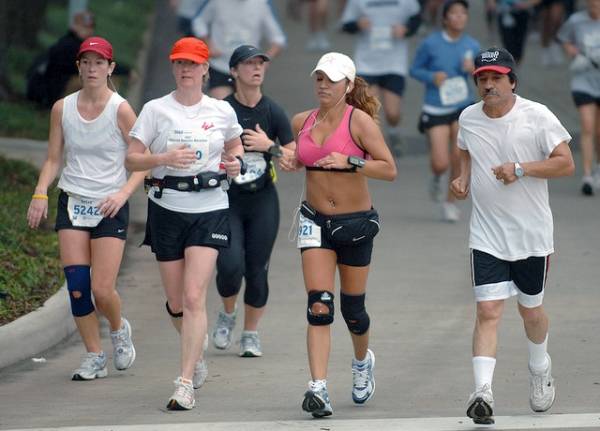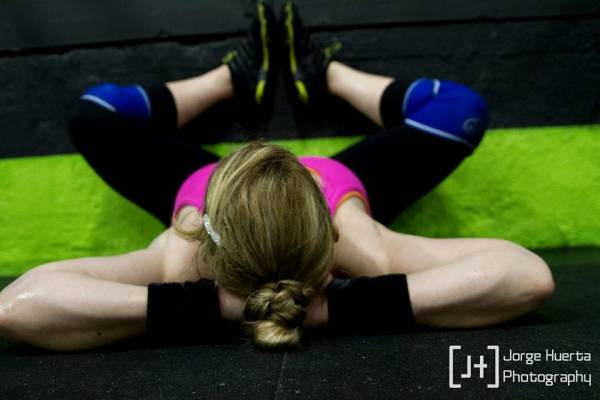Dear Knee Sleeves,
It’s not you, it’s me. I think we have grown apart, and it’s time we stopped seeing each other. I won’t be wearing you anymore.
What?
Yeah, I said it. I am breaking up with my knee sleeves – and you should, too. I know what you’re thinking: I see top CrossFit athletes wearing knee sleeves, so shouldn’t I wear them as well? I used to be pretty committed to my knee sleeves, too, so you’re not alone in feeling that way.
But ifKendrick Ferrisdoesn’t need them, then neither do you.<strong”>Let me explain why.</strong”>
RELATED:The Advantages of Knee Sleeves: What They Are and When to Wear Them
Do Knee Sleeves Actually Prevent Injuries?
In a randomized clinical trial with 74 patients a variety of tests were created to see if knee sleeves have any benefit. One group performed a series of exercises with knee sleeves and another group performed the same exercises without knee sleeves. The study found a statistically significant reduction in pain when knee sleeves were used.
“The main benefits seem to come from the heat retention that the sleeve provides. By keeping the joint warm, people feel less pain and discomfort in their joints while exercising.”
For people who are experiencing osteoarthritis in their knee, knee sleeves proved to be an effective solution to reduce pain.1The main benefits seem to come from the heat retention that the sleeve provides. By keeping the joint warm, people feel less pain and discomfort in their joints while exercising.2
Another study examined proprioception of knee sleeves during a fatigued or non-fatigued state. 64 subjects underwent testing in a military hospital. The four metrics used included: braced (with knee sleeves), not braced (without knee sleeves), fatigued, and not fatigued. The study found that individuals with a good sense of joint positioning reported a perceived benefit from knee sleeves in a fatigued state.3
RELATED:Getting the Most Out of Assistive Gear: A Motor Patterning Perspective
All the information reported above is great news – for your grandma. Let’s see what the test results say about real athletes using knee sleeves in real situations.
One study looked at healthy collegiate football athletes with no history of knee problems who were on an active roster at the time of the study. The athletes were put through a series of jump tests. There were four groups: non braced, wearing knee sleeves, wearing knee sleeves with bilateral metal supports, and another group using a prophylactic knee brace. Researchers found no difference in the results between these four groups.6

But they did find that the group who wore knee sleeves had a lower chance of finding a spouse because they seemed to smell really bad.
A similar study followed an entire college football team for two full years to study the effectiveness of prophylactic knee braces. Prophylactic knee braces are the big, black braces you see offensive linemen (the fat guys) wearing in football. The researchers found there was actually a higher rate of injury in the group wearing those knee braces. Even though knee braces were studied and not knee sleeves, it is still interesting to think about.7
Then there’s CrossFit Games competitor Talayna Fortunato. She believes knee sleeves have helped her with patella tracking and injury prevention, but acknowledges this could be nothing more than a placebo effect. She is also a physical therapist, so this is someone who knows more than the average competitor.
RELATED:The Most Effective Ergogenic Aid for Your Performance
Does Wearing Knee Sleeves Boost Performance?
When compression clothing is worn for extended periods after exercise, like wearing compression clothing all day after exercise, there is a statistically significant decrease in soreness and a small increase in performance the following day. A study posted in Pubmed indicated a slight improvement (1-2%) in performance when compression was applied continuously for 24 hours.4
So what does that translate to if we assume a direct correlation for weightlifting and metabolic conditioning?
- If your “Fran” time is 2:30, your time would potentially improve to somewhere between 2:27 and 2:29.
- If you have a 300lb front squat, your lift would potentially go up three to six pounds (time to get the 2.5-pound plates ready).
So we are getting a minimal increase in performance, and only if we are wearing compression for 24 hours following our workout – not just knee sleeves during our workout. In addition, other studies show only increased recovery and no increase in performance.5
“So we are getting a minimal increase in performance, and only if we are wearing compression for 24 hours following our workout – not just knee sleeves during our workout.”

Should We Be Compressing All Joints?
If we are going to compress our knees using sleeves, shouldn’t we also consider compressing our elbows for overhead work? I see few people with elbow sleeves compared to the amount of people using knee sleeves. If there are benefits, we should definitely consider compressing other joints such ankles, hips, and shoulders.
Strategies for Sore Knees and Joints
If our knees are cracking or painful, the best answer is not a Band-Aid (aka, a knee sleeve). Instead, we should address the warning signs and prevent injury by using a proper warm-up and mobility drills to help our joints sit in the optimal positions. Let’s go over some mobility ideas to address the actual problems going on in the knees.
RELATED:5 Simple Solutions for Anterior Knee Pain
Look Downstream
If you are missing mobility in your ankle, it could be putting your knee in a bad position. Try a banded ankle mobility drill (3.00) If you have tight calves, stretch out your sticks, son. (3.49)
You could also work on the high calf (gastrocnemius) (0.38)
Look at Your Knee
Get full extension in your knee and get some voodoo floss on your patella.
Look Upstream
Create some space in your joint by working on your suprapatellar pouch (the space right above your knee cap). Here are two ideas: compression tack and floss (1:13) and unglue your kneecap. (1.37)
Tight quads may also be contributing to your knee pain, try the couch stretch. (2:21)
Drink Water
If you have creaky knees, it may be from dehydration. Make sure you are drinking enough water: half your body weight in ounces or roughly one ounce per kilo. A 220-pound person (100 kilos) would need to get just over 110 ounces of water per day.
RELATED:An Athlete’s Guide to Hydration: When, What, and How Much
Take Supplements
In the case of joint soreness from arthritis, supplements that contain glucosamine HCI have been clinically proven to reduce pain and inflammation from arthritis.
Don’t try to do every suggestion above at once. Pick one or two and test it out for a week. See which strategy works for you.
Why It’s Time to Break Up With Your Knee Sleeves
The research is clear. Knee sleeves are helpful for managing pain in people who already have arthritis. They also give people a sense of joint positioning. But using proper mobilization techniques is a better method for joint positioning because you can see the difference during your test and retest. Compression is only helpful when worn for extended periods of time, not just for one to two hours while you are exercising.
The bottom line is you should have a warm-up and mobility piece planned to accompany your workout (don’t wing it, that never works), and you should use the ideas above to identify and manage issues contributing to any knee pain.
“Compression is only helpful when worn for extended periods of time, not just for one to two hours while you are exercising.”
If you truly believe there are benefits to knee sleeves, then it’s time you started drinking your own Kool-Aid and just upgrade to the full-body sleeve. For the rest of us, its time to man up (like Kendrick Ferris) and ditch the knee sleeves.
References:
1. Bryk FF., et al. “Immediate effect of the elastic knee sleeve use on individuals with osteoarthritis.” Rev Bras Reumatol. 2011 Sep-Oct;51(5):440-6. Accessed October 22nd 2014.
2. Mazzuca SA., et al. “Pilot study of the effects of a heat-retaining knee sleeve on joint pain, stiffness, and function in patients with knee osteoarthritis.” Arthritis Rheum. 2004 Oct 15;51(5):716-21. Accessed October 22nd 2014.
3. Tiggelen DV., et al. “The effects of a neoprene knee sleeve on subjects with a poor versus good joint position sense subjected to an isokinetic fatigue protocol.” Clin J Sport Med. 2008 May;18(3):259-65. doi: 10.1097/JSM.0b013e31816d78c1. Accessed October 22nd 2014.
4. Hamlin MJ., et al. “Effect of compression garments on short-term recovery of repeated sprint and 3-km running performance in rugby union players.” J Strength Cond Res. 2012 Nov;26(11):2975-82. doi: 10.1519/JSC.0b013e3182711e0b. Accessed October 22nd 2014.
5. Duffield R., et al. “The effects of compression garments on intermittent exercise performance and recovery on consecutive days.” Int J Sports Physiol Perform. 2008 Dec;3(4):454-68. Accessed October 22nd 2014.
6. Mortaza N., et al. “The Effects of a Prophylactic Knee Brace and Two Neoprene Knee Sleeves on the Performance of Healthy Athletes: A Crossover Randomized Controlled Trial.” PLoS One. 2012; 7(11): e50110. Accessed October 22nd 2014.
7. Rovere, G., et al. “Prophylactic knee bracing in college football.” American Journal of Sports Medicine, vol. 15, no. 2, pp. 111-116, 19. Accessed October 22nd 2014.
Photos 1 & 3 courtesy ofJorge Huerta Photography.
Photo 2 “2007 Houston Marathon 18” by Ed UthmanAttribution-ShareAlike License.






